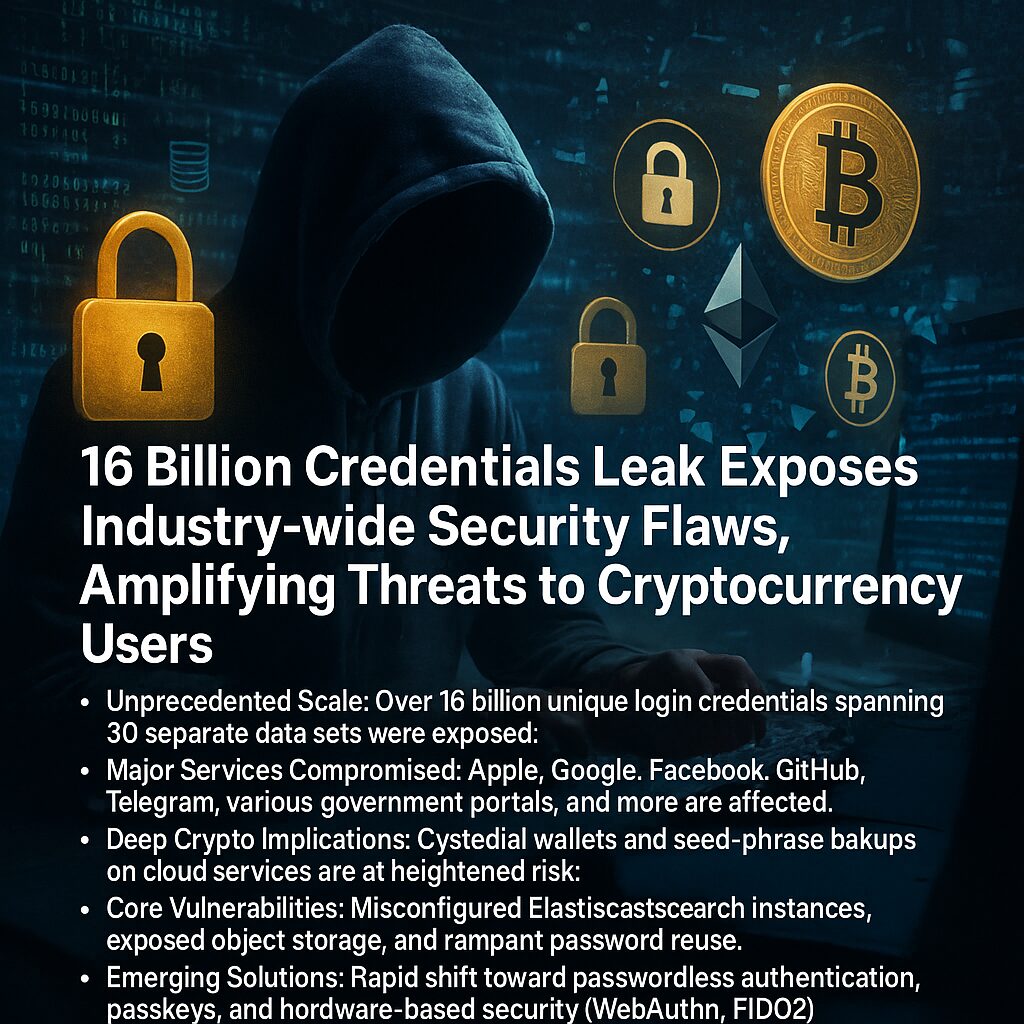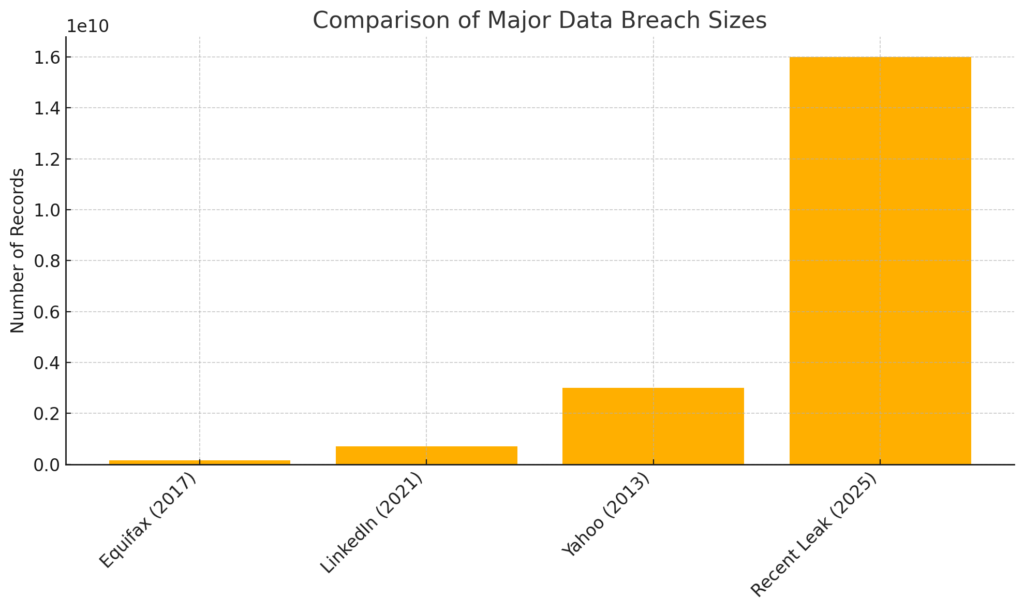
Main Points:
- Unprecedented Scale: Over 16 billion unique login credentials spanning 30 separate data sets were exposed.
- Major Services Compromised: Apple, Google, Facebook, GitHub, Telegram, various government portals, and more are affected.
- Deep Crypto Implications: Custodial wallets and seed-phrase backups on cloud services are at heightened risk.
- Core Vulnerabilities: Misconfigured Elasticsearch instances, exposed object storage, and rampant password reuse.
- Emerging Solutions: Rapid shift toward passwordless authentication, passkeys, and hardware-based security (WebAuthn, FIDO2).
- Actionable Best Practices: Immediate password updates, MFA adoption, use of password managers, and movement of crypto assets to cold storage.
1. Unprecedented Scale: Anatomy of the 16 Billion Credential Leak
On June 20, 2025, CyberNews released a bombshell report revealing that its research team had analyzed 30 distinct data sets containing leaked credentials, whose combined total astonishingly reached 16 billion individual records. Only one of these data sets had previously been detected—a mysterious archive of 184 million credentials—meaning that virtually all of this intelligence is fresh to threat actors. The average size of each database exceeded 550 million records; the smallest set still contained over 16 million entries. CyberNews warns that this mass of “fresh, weaponizable intelligence” lays the groundwork for large-scale credential stuffing and targeted account takeovers.
2. Major Services and Multifactor Authentication at Risk
The leaked credentials include login information for top-tier online services: Apple, Google, Facebook, and professional platforms like GitHub and Telegram, as well as various government portals. Alarmingly, the data troves also contained tokens, cookies, and metadata harvested by information-stealing malware—meaning many organizations without robust multi-factor authentication (MFA) or modern security protocols are particularly vulnerable. Threat actors armed with valid tokens or session cookies can circumvent traditional password checks entirely, rendering single-factor defenses nearly moot.
3. Implications for the Cryptocurrency Ecosystem
Cryptocurrency holders face acute risks in the wake of this leak. Security experts predict a surge in account takeovers, especially targeting custodial wallet platforms and exchanges that rely on email-based authentication. Moreover, several popular wallet services offer password-protected, cloud-based backups of seed phrases. Attackers who obtain these credentials can directly derive private keys, potentially draining wallets of all funds. Depending on the breach’s fallout, exchanges may be forced to mandate global password resets, implement emergency asset-lock protocols, or even temporarily suspend withdrawals to contain damage.
4. Root Causes: Cloud Misconfigurations and Password Reuse
Investigation suggests that a significant portion of the leaked data originated from unsecured Elasticsearch instances and publicly exposed object storage buckets—misconfigurations that leave entire databases accessible without authentication. Meanwhile, password reuse remains endemic: a single breached password can unlock multiple services. These twin failings—improper cloud access controls and human tendencies toward simple, reused credentials—form the backbone of the attack surface.
5. The Move Towards Passwordless Authentication and Passkeys
In response to such breaches, organizations are accelerating their adoption of passwordless solutions. WebAuthn, the W3C standard for secure, hardware-backed authentication, reduces average login times from 12 seconds with passwords to under 2 seconds via biometrics or security keys. The FIDO Alliance reports that 74% of consumers are now aware of passkeys, and enterprises are rolling out widespread support for these credentials in 2025. Meanwhile, the global market for passwordless technology is projected to exceed $20 billion in 2025. This paradigm shift promises to render stolen passwords useless and sharply curtail credential-based breaches.
6. Best Practices for Cryptocurrency Security
- Immediate Password Rotation: Change all passwords, especially on exchanges and custodial services.
- Enable MFA Everywhere: Prefer hardware or software authenticators over SMS-based codes.
- Use a Reputable Password Manager: Generate and store unique, complex passwords for every service.
- Migrate Seed Phrases to Cold Storage: Avoid cloud-based backups; opt for air-gapped hardware wallets or paper backups kept offline.
- Monitor for Credential Exposure: Leverage dark-web monitoring services to receive alerts if your email or password appears in new leaks.
7. Figure 1: Comparison of Major Data Breach Sizes
Below is a bar chart illustrating how the recent 16 billion-record leak dwarfs even the most infamous breaches in history.

Figure generated with user-visible Python code.
8. Looking Ahead: Toward a More Secure Digital Frontier
While the scale of the June 2025 leak is staggering, it has galvanized the industry toward stronger defenses. Cloud providers are enhancing default access controls; developers are integrating zero-trust architectures; and users are demanding passwordless options. In the cryptocurrency domain, innovations such as multi-signature wallets, threshold key management, and decentralized identity (DID) frameworks are gaining traction, promising to distribute trust and secure keys without a single point of failure.
Conclusion
The exposure of 16 billion credentials represents a watershed moment in the evolution of cybersecurity threats. It underscores longstanding flaws—cloud misconfigurations and password reuse—while highlighting the fragility of password-based systems. For cryptocurrency users, the stakes are even higher: compromised credentials can translate directly into lost assets. Yet this crisis also heralds progress: governments, enterprises, and individuals are embracing passwordless authentication, robust multi-factor safeguards, and decentralized key-management schemes. By adopting these best practices and emerging technologies, the digital community can move toward a future where breaches of this magnitude become relics of the past.

